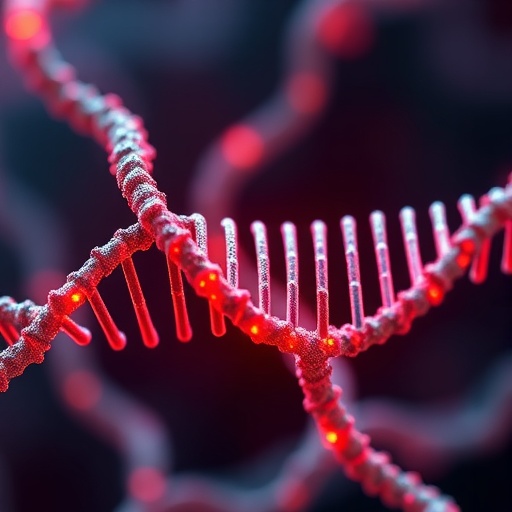In a landmark advance that promises to transform the landscape of synthetic biology and molecular diagnostics, researchers have engineered a new class of compact RNA sensors capable of interpreting and processing multiple biochemical inputs with unprecedented complexity. This breakthrough, detailed in a recent publication in Nature Chemistry, marks a pivotal moment in the development of RNA-based molecular circuitry, where the elegant simplicity of RNA molecules meets sophisticated computational logic.
At the heart of this innovation lies the ability to encode intricate logical functions—traditionally the domain of electronic circuits—within the secondary and tertiary structures of RNA strands. By evolving and precisely designing modular RNA sensors, the research team has unlocked the capacity for these biomolecules to perform combinatorial analyses, effectively functioning as nanoscale decision-making agents. This capacity to handle multiple inputs simultaneously opens a portal to applications from advanced biosensing to programmable therapeutics.
The research confronts longstanding challenges in RNA engineering: maintaining compactness and stability while exponentially increasing functional complexity. Classical RNA devices often suffer from bulky architectures and limited responsiveness to multiple signals. Here, the investigators employed a de novo design approach, crafting sensors that achieve multi-input logic operations while preserving minimal footprint. This compactness is critical for biological integration, allowing these sensors to operate efficiently within the crowded environment of living cells.
These RNA sensors harness an array of molecular mechanisms, including conformational switching, ligand-induced folding, and catalytic activation. By cleverly coupling these phenomena, the authors created sensors that not only detect different molecules or ions but also compute functions such as AND, OR, NAND, and NOR gates. The dynamic interplay of multiple input signals leads to precise output responses, demonstrating reliable and robust computational activity.
Crucial to the success of these sensors is the modular assembly strategy. Through combining smaller RNA motifs, each responsive to individual inputs, the team built layered architectures where sensor modules communicate and integrate signals synergistically. This approach resembles the way electronic circuits combine logic gates to achieve complex computations, yet it exploits the unique chemical versatility and conformational plasticity of RNA.
Biophysical characterizations revealed the exquisite sensitivity and specificity of these RNA devices. Using techniques such as fluorescence resonance energy transfer (FRET) and selective 2’-hydroxyl acylation analyzed by primer extension (SHAPE), the researchers mapped real-time folding changes and structural transitions triggered by ligand binding. These insights confirmed that input signals induce conformational rearrangements that directly facilitate or inhibit downstream activity, underpinning the sensor’s logic output.
The implications of these compact RNA sensors are vast. In diagnostics, they can be programmed to recognize combinations of biomarkers, enhancing disease detection accuracy by responding only when a precise molecular signature is present. Therapeutically, these sensors could control gene expression or drug release in response to complex cellular states, potentially minimizing side effects by ensuring activity occurs only under predefined conditions.
Moreover, the compact nature of these RNA-based logic gates facilitates incorporation into synthetic gene circuits, paving the way for programmable cells capable of sophisticated decision-making. This could enable living therapies that adapt in real-time to their environment or engineer microbes that process environmental signals for bioremediation or biosynthesis applications.
Intriguingly, the study also highlights the potential of these sensors to operate autonomously without the need for auxiliary protein machinery. This feature substantially reduces design complexity and opens possibilities for in vitro applications where external regulation might be impractical or undesired.
Synthetic biology has long eyed RNA as a promising medium for building molecular devices due to its dual capability to store information and fold into diverse structures. This work leaps forward by moving beyond single-input aptamers or ribozymes toward dynamic networks capable of evaluating Boolean logic. It provides a rigorous framework to rationally engineer sensor complexity while maintaining performance, thereby addressing a critical bottleneck in the field.
The study’s design principles are broadly applicable and can be expanded to accommodate additional inputs, creating higher-order logic circuits. As RNA synthesis and computational modeling technologies advance, we can anticipate even more intricate molecular machines, potentially rivaling the complexity of natural cellular networks.
While challenges remain—such as ensuring stability in physiological conditions and avoiding off-target interactions—the robustness of these compact RNA devices in varied environments reported by the authors is encouraging. Their modularity also allows future integration with other nucleic acid technologies, such as CRISPR-based systems, to engineer increasingly autonomous and context-responsive biological tools.
This exploration into RNA’s computational capabilities reinforces the molecule’s status as a central player in synthetic molecular programming. By capitalizing on RNA’s natural folding and binding properties, the researchers have propelled the field towards a future where programmable RNA circuits can seamlessly interface with biological systems, heralding a new era of molecular precision.
In essence, these compact RNA sensors bridge the gap between simple molecular recognition and elaborate signal processing, offering a versatile molecular platform that combines the speed and sensitivity of nucleic acids with the versatility of logical engineering. As synthetic biology matures, innovations like this will undoubtedly catalyze breakthroughs across medicine, environmental science, and biotechnology.
The full potential of these multifaceted RNA sensors will unfold as more researchers adopt and refine these designs. Their ability to intricately sense, compute, and respond at the molecular level embodies the promise of programmable biology and underscores the ingenuity of leveraging nature’s fundamental building blocks to create new forms of life-inspired technology.
Subject of Research: Development of compact RNA sensors capable of complex multi-input logical functions.
Article Title: Compact RNA sensors for increasingly complex functions of multiple inputs.
Article References:
Choe, C.A., Andreasson, J.O.L., Melaine, F. et al. Compact RNA sensors for increasingly complex functions of multiple inputs. Nat. Chem. (2025). https://doi.org/10.1038/s41557-025-01907-8
Image Credits: AI Generated




